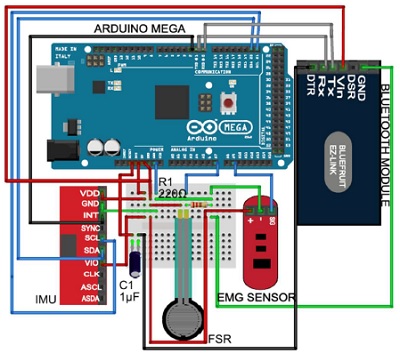Description
This project is focused on the design of a wearable device for measuring muscle activity and analyzing the data to detect muscle fatigue and muscle growth.
Based on the results of this project, there appears to be a relationship between the muscle activity (EMG) and muscle fatigue in both long-term and short-term trends. For example, the mean EMG voltage with respect to time increases by 350%, while the maximum peak EMG voltage increased by 533%.

Figure A.1 shows the Version one of the devices. It has sensors for gait tracking in addition to the version 1. These sensors are the described as follows
Triple axis Accelerometer and Gyro breakout MPU 6050:
It has a MEMS 3-axis gyroscope and a 3-axis accelerometer with an onboard Digital Motion Processor™ (DMP™) on the same board. It can be connected to the Arduino using the SCL and SDA pins as shown. The sensor works at a low voltage of about 2.3 – 3.4 V. The 3-axis accelerometer has a programmable full-scale range of ±2g, ±4g, ±8g, and ±16g. The 3-axis Gyro has a sensitivity up to 131 LSBs/dps and a full-scale range of ±250, ±500, ±1000, and ±2000dps.
Force Resistive Sensor
The FSR from Interlink Electronics has a flexible 0.72″-diameter circular pad. It is light (0.25 g), and extremely thin (0.02″), and it has a circular active sensing area with a diameter of 0.58″. The sensor can sense an applied force from 0.2N to 20N.



Reviews
There are no reviews yet.